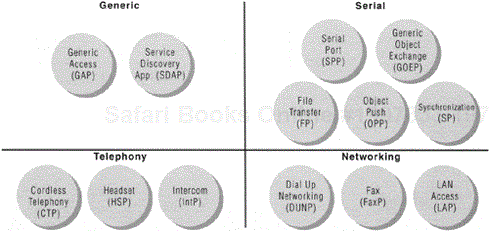Volume 2 of the specification consists of the profiles. These are intended to promote interoperability among many implementations of the protocol stack that is specified in volume 1. In this chapter we discuss the general nature of the profiles—the rationale for generating them, their history and evolution and the interrelationships among them. Each of the version 1.0 profiles is then examined in more detail in subsequent chapters.
Profiles spring from usage cases. Chapter 3 discussed the usage scenarios that were part of the development of the version 1.0 specification (although not all usage cases resulted in a corresponding profile for version 1.0). Many of the profiles can be grouped together based upon the shared elements of their usage scenarios; this is how the profiles are grouped into chapters in this part of the book. The profiles also can be grouped into families based upon their technical underpinnings; in many cases these map in a straightforward manner to usage scenario relationships, although in other cases the technical relationship (for example, of fax to headset) is not so obvious. Furthermore, the version 1.0 specification contains additional profiles that do not directly embody usage cases. These include the generic access profile, the service discovery application profile, the generic object exchange profile and the serial port profile. Each of these profiles can be considered a transport profile which defines a common basis of shared characteristics upon which other application profiles can be built (or, in object-oriented terminology, these profiles are classes from which other profiles, or subclasses, inherit).
Figure 11.1 depicts the version 1.0 profile families based upon their technical relationships. A similar figure appears in multiple places in volume 2 of the specification. That figure depicts these relationships in a "nested container" sort of representation, while Figure 11.1 uses an object hierarchy representation, but both diagrams convey the same information. The abbreviations in parentheses in the figure introduce the shorthand nomenclature that is used in the remaining chapters of Part 3 to name the profiles. These abbreviations are used for convenience; in some cases (but not all) they are consistent with similar abbreviations for the profiles that are used in the specification.

Figure 11.1. The Bluetooth version 1.0 profile families, based upon protocol stack relationships, in class hierarchy representation.
This chapter describes each of the profiles according to the relationship shown in Figure 11.1. The remaining chapters of this part of the book, though, examine the profiles in logical groupings based upon the relationships of the services that each profile provides. There are multiple ways of viewing several of the profiles and thus there are multiple ways to group the profiles. This chapter presents one such grouping, that of the technical elements shared among profiles (which is consistent with the version 1.0 specification, although it does not propose any overt grouping at all other than including a different representation of the figure shown above). Figure 11.2 depicts the logical, service-based grouping that we use in discussing these profiles in subsequent chapters. One example of these multiple viewpoints is that of the headset profile. As depicted in Figure 11.1 in the profile hierarchy, headset is a derivative of the serial port profile. However, from a functional or services point of view the headset profile could be considered to be part of the telephony profile group, as shown in Figure 11.2, and thus we include it in Chapter 13 along with cordless telephony and intercom. Another example is that of the fax profile, which from a technical perspective is also a serial port profile derivative. Our treatment of the fax profile in this book, though, is alongside that of the dial-up networking and LAN access profiles, as part of what we consider a "networking" category,[1] a group which the specification does not address.
This discussion and the figures are intended only to point out that there are multiple ways in which to categorize the version 1.0 profiles. The choice of which method to use is probably best made depending upon the purpose and circumstances surrounding the need to group the profiles in the first place, and most distinctions are not likely to be drastically different. However, because the number of profiles is expected to grow over time, with the SIG already planning to add quite a few new ones (as discussed in Chapter 16), the act of grouping the profiles becomes more advantageous, and the different ways of doing so should not be confused.
Generic Profiles: . This group is composed of the generic access profile, which is the root of all profiles, and the service discovery application profile, which provides a framework for mapping from the application layer to the SDP layer of the stack.
Telephony Profiles: . In the object hierarchy view, these are the profiles that imply the use of TCS-BIN for telephony control functions. This group includes the cordless telephony and intercom profiles (in Chapter 13 we consider the headset profile in the telephony group also, although from the technical perspective it is part of the serial port group).
Serial Port Profiles: . All of the remaining profiles are part of the serial port group. However, this group is further subdivided. Direct derivatives of the serial port profile are the dial-up networking, fax, headset and LAN access profiles; as well as the generic object exchange profile. The latter in turn is the parent of the remaining object exchange group profiles, namely file transfer, object push and synchronization. While we treat this latter group (the object exchange profiles along with the basic serial port profile) identically in this book, some of the other members of the serial port profile family are categorized differently. Specifically, as already noted, the headset profile is examined in the telephony group, and the remaining serial port profile family members—fax, LAN access and dial-up networking—are treated as a networking family, which is examined in Chapter 15.
In each of the remaining chapters of Part 3 we examine a group of profiles as described above. Each chapter is organized such that it addresses:
the common elements of the profiles in that group;
the history of each profile; and
an examination of each profile, including how it maps to the protocol stack and how applications might use it.
In addition, wherever possible, we offer insight about the rationale, design thought process and future possibilities of the profiles based upon our participation in the SIG when the profiles were being developed.
[1] While it may not be obvious how a fax profile fits within a networking category, consider that the fax usage scenario, like dial-up networking and LAN access, uses a Bluetooth device as a "gateway" to a wide area network for data communication. Chapter 15 further elaborates this point.

